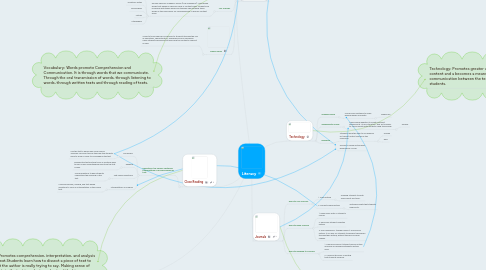
1. Close Reading: Promotes comprehension, interpretation, and analysis of any piece of text.Students learn how to dissect a piece of text to understand what the author is really trying to say. Making sense of the small concepts in the text in order to understand the bigger picture.
2. Vocabulary: Words promote Comprehension and Communication. It is through words that we communicate. Through the oral transmission of words, through listening to words, through written texts and through reading of texts.
3. Vocabulary
3.1. Tier 1 Words
3.1.1. Common/Known Words-basic, everyday words that are a part of most children's vocabulary. Words in everyday conversation, that are learned by hearing family, peers, and teachers use them when speaking.
3.1.1.1. Big
3.1.1.2. Small
3.1.1.3. House
3.1.1.4. Family
3.1.1.5. Table
3.2. Tier 2 Words
3.2.1. High-Utility Academic Words (High-Frequency)- Frequently occurring words that appear in various contexts and topic and play an important role in verbal functioning across a variety of content areas. Cross-curricular terms- example--->terms like justify and predict frequently appear in Science, Social Studies, and English texts. Learned primarily through reading and explicit instruction.
3.2.1.1. Justify
3.2.1.2. Explain
3.2.1.3. Expand
3.2.1.4. Predict
3.2.1.5. Summarize
3.2.1.6. Maintain
3.3. Tier 3 Words
3.3.1. Domain Specific Academic Words (Low-Frequency)- Specialized words that appear in specific fields or content areas. Students are unfamiliar with these words and teachers should teach these words as the need arises for comprehension in specific content areas.
3.3.1.1. Isotope
3.3.1.2. Techtonic Plates
3.3.1.3. Carcinogens
3.3.1.4. Mitosis
3.3.1.5. Lithosphere
3.4. Frayer Model
3.4.1. A way to teach specific vocabulary to students through the use of definitions, characteristics, examples and non-examples. Helps students remember the word and the context in which it is used.
4. Close Reading
4.1. Definitions: the careful, sustained interpretation of a brief passage of text.
4.1.1. Vocabulary
4.1.1.1. Use the text to define key vocab words. Teachers can select words they feel the students need to know in order to comprehend the text.
4.1.2. Reading
4.1.2.1. Reading the text multiple times in multiple ways to gain a new understanding each time the text is read.
4.1.3. Text-based Questions
4.1.3.1. Using Questions to help students understand the meaning of the text
4.1.4. Interpretation as a Whole
4.1.4.1. Using vocabulary, reading, and text-based questions to form an interpretation of the overall text.
5. Journals: Promote a unique way of writing and expressing oneself. No added pressure of producing great writing. A way for students to practice their writing skills on a daily/weekly basis.
6. Technology: Promotes greater understanding of content and a becomes a means of communication between the teacher and students.
7. Journals
7.1. Ways to Use Journals:
7.1.1. 1. Free-Writing
7.1.1.1. Allowing students to write freely about any topic.
7.1.2. 2. Prompt-based Writing
7.1.2.1. Writing prompts that students respond to.
7.2. Ways to Read Journals
7.2.1. 1. Read every entry in student's journal.
7.2.2. 2. Read only student-selected entries.
7.2.3. 3. Free-expression- teacher doesn't read journal entries. It is a way for students to express themselves through their writing, without the fear of being judged.
7.3. Ways to Respond to Journals
7.3.1. 1. Check and correct student journal entries and work on polishing student's writing skills.
7.3.2. 2. Uncorrected form of writing that students produce.
8. Technology
8.1. Grading Online
8.1.1. Using online software to make grading easier and faster.
8.1.1.1. GradeCam
8.2. Assignments Online
8.2.1. Using online websites to create and post assignments. Its an interactive way for teachers to communicate with students using technology.
8.2.1.1. Weebly
8.3. Research
8.3.1. Students using the Web to do research on topics/content learned in the classroom.
8.3.1.1. Google
8.3.1.2. ERIC
8.3.2. Access to online dictionaries: defining Key Vocab.
